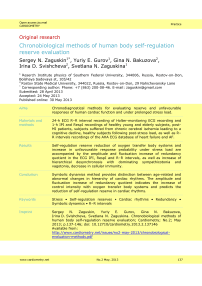Chronobiological methods of human body self-regulation reserve evaluation
Автор: Zaguskin Sergey N., Gurov Yuriy E., Bakuzova Gina N., Svishcheva Irina D., Zaguskina Svetlana N.
Журнал: Cardiometry @cardiometry
Рубрика: Practice
Статья в выпуске: 2, 2013 года.
Бесплатный доступ
Aims Chronodiagnostical methods for evaluating reserve and unfavourable responses of human cardiac function and under prolonged stress load. Materials and methods 24-h ECG R–R interval recording of Holter-monitoring ECG recording and 1-h IPI and RespI recordings of healthy young and elderly subjects, post- MI patients, subjects suffered from chronic cerebral ischemia leading to a cognitive decline, healthy subjects following post-stress load, as well as R– R intervals recordings of the AHA ECG database of heart failure and AF. Chronodiagnostics, using non-linear symbolic dynamics method and redundancy quotient of ECG PI, RespI and R– R intervals; differential temperature survey to evaluate cellular immunity; biocontrolled laser therapy. Results Self-regulation reserve reduction of oxygen transfer body systems and increase in unfavourable response probability under stress load are accompanied by the amplitude and fluctuation increase of redundancy quotient in the ECG IPI, RespI and R–R intervals, as well as increase of hierarchical desynchronosis with dominating sympathicotonia and vagotonia, decrease in cellular immunity, reduction in rate spectrum of the ECG IPI and R–R intervals...
Cardiac rhythms, rr interval, redundancy, self-regulation, stress, symbolic dynamics
Короткий адрес: https://sciup.org/148308740
IDR: 148308740
Текст научной статьи Chronobiological methods of human body self-regulation reserve evaluation
Aims Chronodiagnostical methods for evaluating reserve and unfavourable responses of human cardiac function and under prolonged stress load. Materials and methods 24-h ECG R–R interval recording of Holter-monitoring ECG recording and 1-h IPI and RespI recordings of healthy young and elderly subjects, post-MI patients, subjects suffered from chronic cerebral ischemia leading to a cognitive decline, healthy subjects following post-stress load, as well as R– R intervals recordings of the AHA ECG database of heart failure and AF. Results Self-regulation reserve reduction of oxygen transfer body systems and increase in unfavourable response probability under stress load are accompanied by the amplitude and fluctuation increase of redundancy quotient in the ECG IPI, RespI and R–R intervals, as well as increase of hierarchical desynchronosis with dominating sympathicotonia and vagotonia, decrease in cellular immunity. Conclusion Symbolic dynamics method provides distinction between age-related and abnormal changes in hierarchy of cardiac rhythms. The amplitude and fluctuation increase of redundancy quotient indicates the increase of control intensity with oxygen transfer body systems and predicts the reduction of self-regulation reserve in cardiac rhythms. Keywords Stress • Self-regulation reserves • Cardiac rhythms • Redundancy • Symbolic dynamics • R–R intervals Imprint Sergey N. Zaguskin, Yuriy E. Gurov, Gina N. Bakuzova, Irina D. Svishcheva, Svetlana N. Zaguskina. Chronobiological methods of human body self-regulation reserve evaluation; Cardiometry; No.2; May 2013; p.137-146; doi: 10.12710/cardiometry.2013.2.137146 Available from:
Planning long duration space missions and performing complex work under stress load requires an evaluation of the human body self-regulation and adaptability reserve, probability of unfavourable responses in cardiac and respiratory function. Despite the existence of numerous indirect evaluation methods for body self-regulation reserve and adaptability to environmental unfavourable conditions [1], their prediction capabilities are not conclusively proved. The crucial task is to develop quantitative methods for predicting unfavourable responses and the risk of pathological abnormalities. The successful transient process appears to be significant for the evaluation of human adaptability to changing environmental conditions rather than maintenance of stable homeostasis. The transient process requires energy costs, and its effectiveness depends upon initial coordination of the body system performance. So the evaluation of the body sub-system activity coordination proves to be more efficient [8,10] than observations of solitary homeostasis criteria in predicting the ability to adaptability success. Today, the development of synergetics fostered a number of methods to evaluate adaptability parameters and transient performance. Fractal dimension in cardiac rhythm and respiration ratio [3,4] is shown to be a predictor for successful adaptability to changing or unexpected environmental conditions. The contemporary systemic approach requires consistency and correlation of various parameters in adaptability dynamics. The crucial task is to implement modern systematic non-linear dynamics approaches in evaluation of human adaptability and success of transient process, considering various changing criteria.
Materials and methods
For a 24-h ECG R-R interval recording, the Valenta Holter monitor (NEO scientific production association, Russia) was used. Recordings of 20 patients, aged 50 to 70, who suffered from arterial hypertension, and recordings of 20 healthy subjects of the same age range were analyzed. Besides, 24-h heart rate recordings of PhysyoNet database [15] were analysed, namely, 54 recordings of healthy subjects with normal sinoatrial rate (30 males aged 54 to 76, and 24 females aged 58 to 73), 44 recordings of subjects suffered from congestive cardiac failure (the 34 to 79 age range), 84 recordings of subjects suffered from long-term or paroxysmal atrial fibrillation and atrial fibrillation.
We designed a Family Doctor and Teacher device and implemented it for 1-h IPI and RespI recordings. The series received with the output signals from pulse and respiration sensors and entered into the computer were analyzed in healthy young (20 individuals) and elderly subjects (20 individuals), patients suffered from myocardial infarction (30 individuals), patients suffered from chronic cerebral ischemia leading to a cognitive decline (10 individuals) and healthy subjects after stress loads (10 individuals). Deviations from circahoralian and circadian vegetative rhythms of Kérdö's index, individual minute and heart rate variability (scatter plot, ratio of low to high frequencies, Baevsky’s tension index) of all healthy and sick individuals were analyzed. Non-linear symbolic dynamics methods [2] and redundancy quotient rate parameters [9] were applied to evaluate self-regulation, adaptability reserve and unfavourable response prediction. Additionally, with the same purpose, the cellular immunity of healthy and sick subjects was evaluateed with differential temperature survey method [6]. Computerized automatic respiratory gymnastics [5] and biocontrolled laser therapy [11,12] were used to normalize vegetative status and reconstitute cellular immunity rehabilitating post-stress patients.
Results
Comparison of various chronodiagnostical factors of healthy subjects of various age and subjects suffered from cardiac insufficiency, atrial fibrillation, arterial hypertension and myocardial infarction showed the dynamics of fractality features and redundancy quotient to be the most informative indicator of stress loads. Redundancy quotient R was calculated from formula (1), where E exp – experimental entropy, and E max – maximum entropy, taken to be homogeneous distribution of IPI or ECG R–R intervals:
R = 1 - Eexp (1) E max
While analyzing retrospectively redundancy quotient dynamics of the post-MI patients and patients suffered from arterial hypertension, general regularity was revealed. The amplitude and fluctuation of redundancy quotient increased immediately prior to maximum arrhythmia or maximum ischemia, and in some patients that increase commenced an hour or even two hours before the unfavourable response. Those factors enabled us to assume that the fluctuation parameters of redundancy quotient can be used to evaluate the self-regulation reserve of oxygen transfer body systems and tolerance to stress load for healthy individuals. To prove this assumption, the analysis of redundancy quotient fluctuation parameters has been performed in healthy individuals under stress loads (temporary duty trip to the zone of antiterror activities).
Fig. 1 demonstrates redundancy quotient dynamics for two healthy patients suffered from that stress load. Subject (а) shows no changes in parameters of redundancy quotient dynamics, neither before nor after the stress load or rehabilitation. Maximum recorded amplitude is within 0.04 and 0.14. Subject (b) suffered from the stress load showed rhythmical No.2 May, 2013 139
increase of redundancy quotient fluctuation amplitude (maximum peak is within 0.05 and 0.45). Recovery and reflection period has reduced rhythmical amplitude increase and rate time of redundancy quotient to initial values of stress starting point (curve c) for two weeks. Those patients had no essential individual differences in redundancy quotient before the beginning of stress loads. These factors suggest fluctuation parameters of redundancy quotient being used to predict individual organism resistance to stress or other negative loads, i.e., evaluating reserves and intensity of oxygen transfer body system self-regulation. The amplitude increase and fluctuation time increase of IPI and RespI redundancy quotient dynamics prove this suggestion, though the increase is less intense with healthy individuals during thinking process and emotional responses.
Redundancy quotient delivers more detailed information when analyzing 24-h ECG R–R interval recordings with different averaging, i.e., at varying length of sampling of redundancy quotients in the ECG R–R intervals sequencing. Fig. 2 demonstrates the rate hierarchy difference of this parameter in sick and healthy subjects. The use of different sample periods shows frequency and length of regulation intensity periods of oxygen transfer body systems, their association with day time and decrease moments of self-regulation reserves and adaptability to stress and other environmental loads in particular patients.
Rtfduttidncy- rev
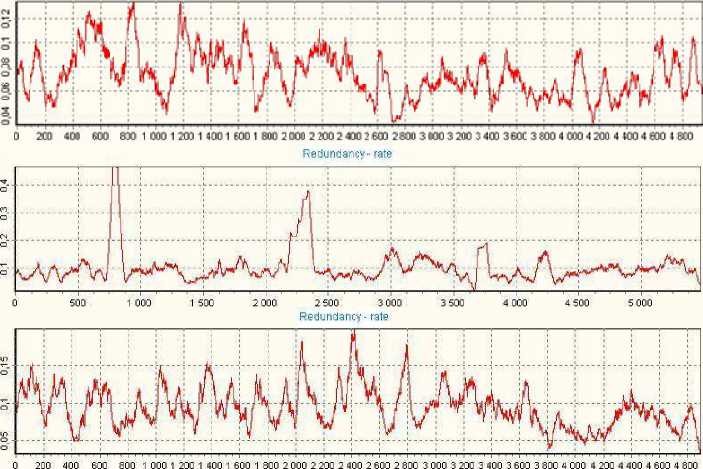
Figure 1. IPI redundancy quotient dynamics for the patient after the long-term stress load (a, high resistance) and for the patient before (b, low self-regulation reserves) and after (с) recovery and reflection period.
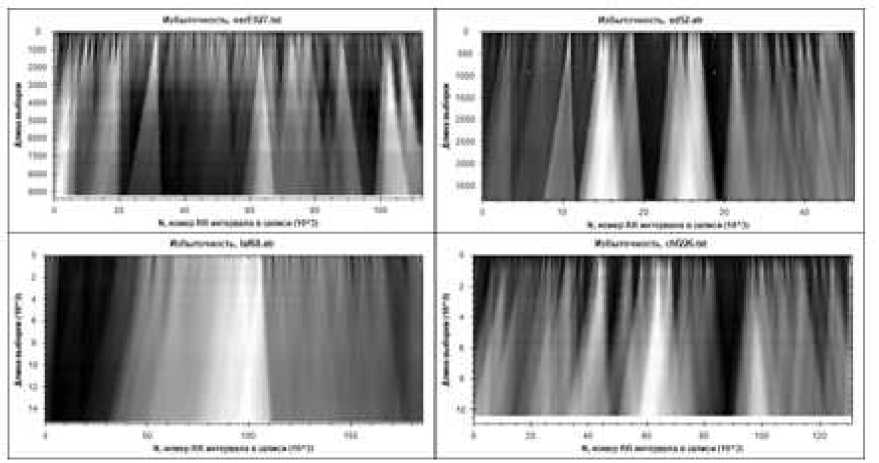
Figure 2. 24-h redundancy diagrams for a healthy subject (at the top) and for a subject suffered from congestive heart failure (at the bottom) with varying periods of sampling of redundancy quotients in the ECG R–R intervals sequencing (axis y). Axis x indicates the R–R interval number to count redundancy from (thousands of R– R intervals scale).
Another method to evaluate human self-regulation reserve can be based on non-linear symbolic dynamics method [2,3]. Functional dynamics of regulatory subsystem was discussed as the interchange of two phases, and the number of activities in each phase was estimated. Heart beat dynamics can be divided into phases of the rise in heart rate (sympathetic tonus prevailing), and the drop in Deflate Rate (parasympathetic tonus prevailing). In each phase the number of heart beats (commonly from 1 to 4) should be counted. Transition from one phase to another can be encoded with a symbol depending on the beat quantity counted in the previous and following phases (Fig.3, to the right). For heart beat dynamics 25 symbols will be enough. In this case the subsystem functional dynamics will be described by one word composed of these symbols. The research of this subsystem functional language appears to be a sustainable method and allows for chronodiagnostics. With a number of features of symbolic dynamics (sizes of vocabularies, conventional entropy and similarity indices) we could reveal specific characteristics of different body states, namely, ageing or pathologies [2, 12]. It turned out that young healthy individuals were characterized with a large variety of vocabulary in comparison with the elderly healthy and the sick ones, and the primary role in the subsystem functional dynamics is played by shorter words (Fig. 4).
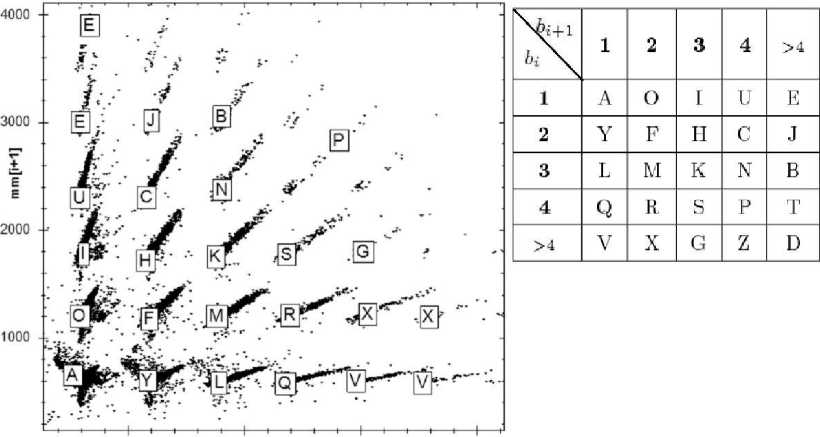
1000 2000 mm[j] 3000 4000
Figure 3. Left: scatter plot of phase length (in milliseconds) of sympathetic or parasympathetic tonus prevailing with one of the subjects, and its coding. You could see the most frequent symbols. Right: coding table depending on the number of heart beats in the current and following phases. For instance, «R» symbol means that the current phase included 4 beats and the following one had 2 beats.
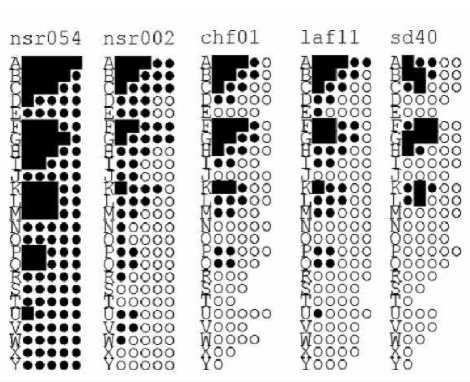
Figure 4. Symbolic dynamics method of ST–diagram for 25 lines describing cardiac rhythm dynamics from left to right as follows: a young healthy individual, an elderly healthy individual, an idividual suffered from cardiac insufficiency, an idividual suffered from atrial fibrillation and a patient suffered from sudden cardiac death. Black squares mark transitions with frequency more than 0.1, black circles – with frequency more than 0.01 but less than 0.1. Empty circles indicate transitions with nonzero frequencies, less than 0.01.
Prediction capabilities of the symbolic dynamics method are shown in Fig. 5. This figure demonstrates the range of coordinates corresponding to values of young and elderly healthy subjects and idividuals suffered from cardiac insufficiency and atrial fibrillation. Chronodiagnostics of these two patients describes that Patient 1 (red field) appears to have some signs of cardiac insufficiency in the early preclinical stage, and Patient 2 (green field) has no pathology, but it is expectable (on dispersion boundaries).
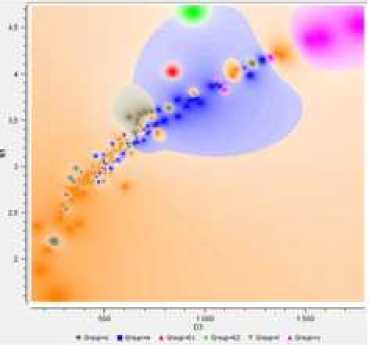
с — the field of indicators for 44 subjects with congestive cardiac insufficiency;
-
1— the field of indicators for 84 subjects suffered from atrial fibrillation;
y— the field of indicators for 10 young healthy subjects;
e — the field of indicators for 54 elderly healthy subjects;
kl indicates subject 1;
k2 indicates subject 2.
Figure 5. IPI symbolic dynamics (1-h recordings).
Fig. 6 shows sizes of vocabularies of two-symbol words for a 24-h recording of apparently healthy groups (e and y) and the sick (с and l) groups. The general quantity decrease of two-symbol words with heart diseases determines more simplified cardio rhythm dynamics [2-4, 16].
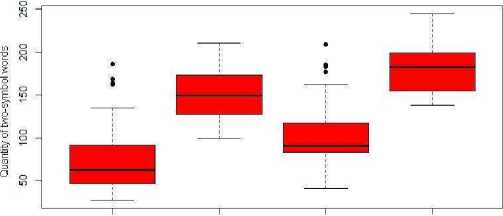
Groups
Figure 6. shows sizes of vocabularies of two-symbol words for a 24-h recording: y - young healthy individuals; e - elderly healthy individuals; c - individuals suffered from congestive heart failure (of all ages); l -individuals suffered from atrial fibrillation (of all ages) [15].
Discussion and conclusions
For individuals suffered from arterial hypertension and post-MI patients, the amplitude and fluctuation increase of redundancy quotient is estimated as the decrease of adaptive abilities and self-regulation reserve, and preliminary figures indicate they can be used to evaluate tolerance to stress of the healthy individuals. It is necessary to predict unfavourable responses and the decrease of resistance to stress loads by assessing a set of indicators. We showed that dynamics evaluation of IPI and RespI redundancy parameters and their interrelations can be an efficient predictor of adaptability and describe self-regulation reserves [3,8,9]. The prime analysis tool will be the well-proven (see above) non-linear dynamics tool [16] according to the method designed by us [2].
Two central problems remain to be relevant in diagnostics of cardiovascular response to stress loads. The first problem is connected with the lack of early disease diagnostics to detect abnormalities in human body performance before pathological abnormalities occur. Symbolic dynamics method, as our researches described, obtains prediction capabilities. The second problem is the following: today establishing accurate diagnosis requires long-lasting (24-h and more) ECG recordings, and it complicates surveying. Implementation of redundancy quotient and symbolic dynamics proved that some problems require only a 1-h recording. Our research implemented non-linear symbolic dynamics method [16] with coding words varying in their length for the first time, which includes applying scattering diagrams of ECG R–R interval minimum and maximum peaks [10]. As our research revealed [3,4,12], diagnostic methods of abnormality in subsystem consistency are highly informative. The first class of system disruption in coodination can be detected while comparing rhythms of various periods of the same organization level. For instance, for human organs and body systems disruption can be detected with features of relationship dynamics of rate of heart contraction and respiratory rate. This disruption in coodination characterizes precursory symptom of heart and respiratory diseases, as well as predicts unfavourable vegetative human responses under stress loads, development of resistant sympathicotonia or vagotonia. The second class of system disruption in timing is determined as the disruption of optimum ratio and coordination for rhythms of various periods, in our case it is the ratio of cardio rhythms of various periods.
To restore self-regulation reserve and improve adaptability to unfavourable environmental conditions, stress loads in particular, it is necessary to estimate and restore, when required, circahoralian and circadian vegetative rhythms for protection and rehabilitation. Chronodiagnostics of their abnormality should be combined with respiratory gymnastics [5]. By increasing the time of inhaling against the exhalation time the tonus of sympathetic control can be enhanced against the tonus of parasympathetic control, and vice versa in the case of No.2 May, 2013 144
vagotonia. Another essential component to evaluate self-regulation reserve and its regeneration is the cellular immunity evaluation method with the developed differential temperature survey [6], and immune reconstitution by applying biocontrolled laser vein-area treatment of blood, lien and thymus gland [11,14]. The important post-stress rehabilitation component is normalization of calcium metabolism with the help of biocontrolled electrophoresis [13], and normalization of blood microcirculation and blood venous return with the help of biocontrolled pneumomassage [7].
Statement on ethical issues
Research involving people and/or animals is in full compliance with current national and international ethical standards.
Author contributions
S.Z., Y.G., G.B., I.S. and S.Z. developed the concept, prepared the manuscript and analyzed the data, G.B. and I.S. drafted the manuscript, S.Z. read and met the ICMJE criteria for authorship. All authors read and approved the final manuscript.
Acknowledgements
The research is performed with financial support from Russian Humanitarian Science Foundation (RHSF) within Research and Development Project of RHSF «Development of Evaluation Methods and Restitution of Human Body Reserve», project №12-06-00018а.
Conflict of interest
None declared.
Список литературы Chronobiological methods of human body self-regulation reserve evaluation
- Alyakrinsky BS, Stepanova SI. The Law of Rhythm1985. 176 p.
- Gurov YV. Development of the methods of symbolic dynamics for systemic analysis of cardiological processes Rostov-on-Don2012
- Gurov YV, Zaguskin SL. Hierarchy of cardiac rhythms and new methods of chronodiagnostics. Vladikavkazsky medico-biologicheskiy vestnik. 2010;10(17):13-7
- Gurov YV, Zaguskin SL. Chronodiagnostical opportunities of the symbolic dynamics method. Terapevticheskiy arkhiv. 2011;83(4):23-6.
- Zaguskin SL, inventorDevice for respiratory gymnastics. SSSR28.06.90.
- Zaguskina LD, Borisov V, Zaguskin SL, Luchinin V, Zaguskina SS, Belichko NL,inventorsMethod of diagnostics of functional and pathological processes in human body or animal organism. RF16.10.2003.
- Zaguskin SL, Oraevsky VN, Rapoport SI, Grigoriev I, inventorsMethod of pressure control of the pneumomassage cuff unit. RF27.09.96.
- Zaguskin SL. New generation of hardware diagnostic and treatment devices. Izvestiya UFU Tekhnicheskiye nauki. 2010(8):69-75.
- Zaguskin SL. Cellular rhythms and human health.Rostov-on-Don2010. 292 p.
- Zaguskin SL, Gurov YV. Hardware and software systems of chronodiagnostics and biocontrolled chronophisiotherapy. Almanakh klinicheskoy meditsiny. 2008;XVII(2):54-7.
- Zaguskin SL, Zaguskina SS. Laser and biocontrolled quantum therapy. Moscow:Kvantovaya meditsina; 2005. 220 p.
- Zaguskina SS, Zaguskin SL, Gurov YV. Circahoralian rhythms in evaluation of cardiac rhythms variability. Bulletin of Experimental Biology and Medicine. 2008(8).
- Oraevsky VN, Zaguskin SL, Rapoport SI, Grigoriev I, inventorsMethod of compensation of calcium loss of bone tissue. RF27.09.96.
- Terentiev VP, Zaguskina SS, Dodis LI, Zaguskin SL. Biocontrolled quantum therapy in rehabilitation during sanatory stage in post-MI patients. Manual for physicians. Rostov-on-Don: Kvantovaya meditsina; 2005. 30 p.
- Physiological database. Available from: http://www.physionet.org/.
- Voss A, Schulz S, Schroeder IR, Baumert M, Caminal P. Methods derived from nonlinear dynamics for analyzing heart rate variability. Phil Trans R Soc A. 2009;28(367):277-96.

